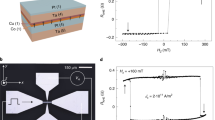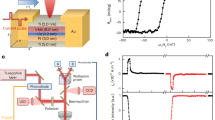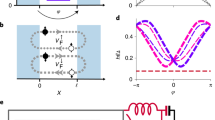Abstract
Electrical control and readout of magnetic states is an important goal in spintronics. But electrical access to quantum spin systems comes at the cost of coupling to electrodes, which reduces the spin lifetimes through relaxation to electron–hole pairs. Here we report an electrically probed single-atom spin that is long-lived thanks to engineering the coupling of individual iron atoms to the nearby metallic electrodes. Using spin-polarized scanning tunnelling microscopy, we show that the excited spin state of these atoms persists for more than ten milliseconds. The lifetime can be tuned by varying the distance to the microscope probe tip—acting as one electrode—and by changing the thickness of the insulating film which separates the atom from the underlying electrode. The cross-section for spin-flip scattering is so small that many thousands of electrons can probe the spin state projectively before it relaxes. Using all-electrical pump–probe spectroscopy, we measure the lifetime of the atom for different tip–atom distances and determine the intrinsic lifetime as a function of the insulator thickness. We explain the tuning of the spin lifetime in terms of the conductance to each of the electrodes, which provides a method to maximize the electrical readout signal for a given lifetime.
This is a preview of subscription content, access via your institution
Access options
Subscribe to this journal
Receive 12 print issues and online access
$209.00 per year
only $17.42 per issue
Buy this article
- Purchase on Springer Link
- Instant access to full article PDF
Prices may be subject to local taxes which are calculated during checkout




Similar content being viewed by others
References
Chappert, C., Fert, A. & Van Dau, F. N. The emergence of spin electronics in data storage. Nat. Mater. 6, 813–823 (2007).
Khajetoorians, A. A. et al. Current-driven spin dynamics of artificially constructed quantum magnets. Science 339, 55–59 (2013).
Sessoli, R., Gatteschi, D., Caneschi, A. & Novak, M. A. Magnetic bistability in a metal-ion cluster. Nature 365, 141–143 (1993).
Gatteschi, D., Sessoli, R. & Villain, J. Molecular Nanomagnets (Oxford Univ. Press, 2006).
Thomas, L. et al. Macroscopic quantum tunnelling of magnetization in a single crystal of nanomagnets. Nature 383, 145–147 (1996).
Gatteschi, D. & Sessoli, R. Quantum tunneling of magnetization and related phenomena in molecular materials. Angew. Chem. Int. Ed. 42, 268–297 (2003).
Brune, H. & Gambardella, P. Magnetism of individual atoms adsorbed on surfaces. Surf. Sci. 603, 1812–1830 (2009).
Wiesendanger, R. Spin mapping at the nanoscale and atomic scale. Rev. Mod. Phys. 81, 1495–1550 (2009).
Khajetoorians, A. A. et al. Itinerant nature of atom-magnetization excitation by tunneling electrons. Phys. Rev. Lett. 106, 037205 (2011).
Khajetoorians, A. A. et al. Spin excitations of individual Fe atoms on Pt(111): impact of the site-dependent giant substrate polarization. Phys. Rev. Lett. 111, 157204 (2013).
Heinrich, B. W., Braun, L., Pascual, J. I. & Franke, K. J. Protection of excited spin states by a superconducting energy gap. Nat. Phys. 9, 765–768 (2013).
Loth, S., Etzkorn, M., Lutz, C. P., Eigler, D. M. & Heinrich, A. J. Measurement of fast electron spin relaxation times with atomic resolution. Science 329, 1628–1630 (2010).
Rau, I. G. et al. Reaching the magnetic anisotropy limit of a 3d metal atom. Science 344, 988–992 (2014).
Donati, F. et al. Magnetic remanence in single atoms. Science 352, 318–321 (2016).
Steinbrecher, M. et al. Absence of a spin-signature from a single Ho adatom as probed by spin-sensitive tunneling. Nat. Commun. 7, 10454 (2016).
Coffey, D. et al. Antiferromagnetic spin coupling between rare earth adatoms and iron islands probed by spin-polarized tunneling. Sci. Rep. 5, 13709 (2015).
Loth, S., Lutz, C. P. & Heinrich, A. J. Spin-polarized spin excitation spectroscopy. New J. Phys. 12, 125021 (2010).
Baumann, S. et al. Electron paramagnetic resonance of individual atoms on a surface. Science 350, 417–420 (2015).
Baumann, S. et al. Origin of perpendicular magnetic anisotropy and large orbital moment in Fe atoms on MgO. Phys. Rev. Lett. 115, 237202 (2015).
Gauyacq, J.-P., Lorente, N. & Novaes, F. D. Excitation of local magnetic moments by tunneling electrons. Prog. Surf. Sci. 87, 63–107 (2012).
Delgado, F. & Fernández-Rossier, J. Spin dynamics of current-driven single magnetic adatoms and molecules. Phys. Rev. B 82, 134414 (2010).
Lambe, J. & Jaklevic, R. Molecular vibration spectra by inelastic electron tunneling. Phys. Rev. 165, 821–832 (1968).
Freedman, D. E. et al. Slow magnetic relaxation in a high-spin iron(II) complex. J. Am. Chem. Soc. 132, 1224–1225 (2010).
Kramers, H. A. Théorie générale de la rotation paramagnétique dans les cristaux. Proc. Acad. Sci. Amsterdam 33, 959–972 (1930).
Steurer, W., Gross, L. & Meyer, G. Local thickness determination of thin insulator films via localized states. Appl. Phys. Lett. 104, 231606 (2014).
Agraït, N., Levy Yeyati, A. & van Ruitenbeek, J. M. Quantum properties of atomic-sized conductors. Phys. Rep. 377, 81–279 (2003).
Acknowledgements
We thank B. Melior for expert technical assistance, A. Macdonald, S. Rolf-Pissarczyk and R. M. Macfarlane for helpful discussions, and P. Willke, F. Natterer and T. Greber for providing comments on the manuscript. We gratefully acknowledge financial support from the Office of Naval Research. N.R. acknowledges financial support from the German Academic Exchange Service (DAAD). K.Y. acknowledges support from the National Natural Science Foundation of China (Grant No. 61471337). W.P. thanks the Natural Sciences and Engineering Research Council of Canada for fellowship support.
Author information
Authors and Affiliations
Contributions
W.P., K.Y., S.B., C.P.L. and A.J.H. designed the experiment. W.P., K.Y., S.B. and N.R. carried out the STM measurements. W.P. and K.Y. performed the analysis, W.P. and C.P.L. designed and implemented the pump–probe protocols, C.P.L. and W.P. developed the model, and W.P. carried out the calculations. W.P. and C.P.L. wrote the manuscript. All authors discussed the results and edited the manuscript.
Corresponding author
Ethics declarations
Competing interests
The authors declare no competing financial interests.
Supplementary information
Supplementary information
Supplementary information (PDF 1820 kb)
Rights and permissions
About this article
Cite this article
Paul, W., Yang, K., Baumann, S. et al. Control of the millisecond spin lifetime of an electrically probed atom. Nature Phys 13, 403–407 (2017). https://doi.org/10.1038/nphys3965
Received:
Accepted:
Published:
Issue Date:
DOI: https://doi.org/10.1038/nphys3965
This article is cited by
-
A solid-state quantum microscope for wavefunction control of an atom-based quantum dot device in silicon
Nature Electronics (2023)
-
Single-molecule electron spin resonance by means of atomic force microscopy
Nature (2023)
-
A solid-state quantum microscope
Nature Electronics (2023)
-
Electron spin resonance of single iron phthalocyanine molecules and role of their non-localized spins in magnetic interactions
Nature Chemistry (2022)
-
Trends in the hyperfine interactions of magnetic adatoms on thin insulating layers
npj Computational Materials (2021)



